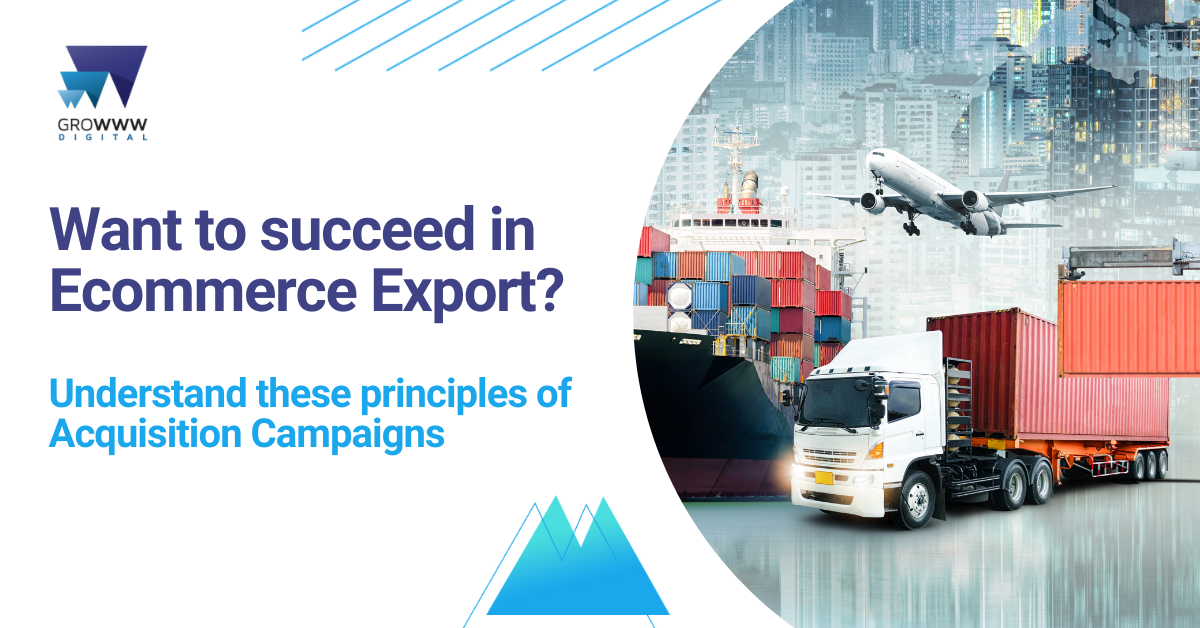
Want to succeed in Ecommerce Export? Understand these principles of Acquisition Campaigns
Want to succeed in Ecommerce Export? Understand these principles of Acquisition Campaigns
“Fail fast to win a new market quickly.”
When expanding your business abroad, acquiring customers is the number one challenge companies face. Acquisition campaigns can help bridge the gap between your business and your ideal customers in a new market. If done well, it’s a shortcut to success and an investment that pays off soon. Let’s take a closer look at what acquisition campaigns are and what mistakes to avoid.
75 pages packed with all you need to know as an ecommerce business before you expand to Czechia, Slovakia, Hungary, Romania, Croatia and Slovenia.
What do we mean when we say acquisition campaigns?
Acquisition campaigns promote a product or services to a new audience and generate relevant traffic to the website. Paid channels include Google Shopping, Google Search, Display Ads (also known as Banner Ads), and Facebook Ads.
When expanding to a new country, your brand is not established yet and therefore people don’t search for your business, products or services. “It usually takes 6-12 months for a new website to ramp up organic traffic, that’s why you can’t depend on organic traffic as it takes time for Google to index your website,” Zoltán Flekács, Head of Performance at Growww Digital informs. He’s seen how paid channels are a quick and efficient way to buy traffic from Google or Facebook and speed up the process of getting first customers.
Why invest in acquisition campaigns?
What is the first action people take when looking for an answer? They Google it. It’s estimated that the leading search engine processes approximately 63,000 search queries every second, which amounts to 5.6 billion searches per day and approximately 2 trillion global searches per year. That’s on average three to four searches each day per person. In other words, every day there are potential customers looking for answers to their problems. For some of those searches, your product could be the answer. Therefore, Google Ads (formerly known as AdWords) are a must.
Another place where customers go for answers is social media. Whether it’s asking for advice or researching brands, it’s where people seek information. According to Nielsen research, 92% of consumers trust word-of-mouth or recommendations. Furthermore, platforms like Facebook offer detailed targeting making it easy for companies to run ads only on relevant audiences. Instagram, TikTok and YouTube ads can give you a competitive edge, but Zoltán reminds brands to focus on the primary channels such as Facebook and Google: “Unless you are a certain size and have an abundant budget, other non-conversion focused channels are of a secondary importance.”

The presence in social media is still a key investment
The 5 main advantages of Google and Social Media ads when expanding abroad
1. Easily scalable – once you figured the best targeting methods in your home country, duplicating and iterating them in a new market is not a rocket sience
2. Cost-effective – you have full control over how much you spend.
3. Easy to control – you can run various A/B tests to see which targeting works the best.
4. Great targeting – whether you want to reach a cold or warm audience, retarget recent website visitors or bid on chosen keywords, you have the option to choose the right audience.
5. Ranking improvement – with ads you can show up high in the results page as paid advertisement above organic results for keywords even if your website has low domain authority
Want your Ads to perform? Google Shopping in place, copywriting on point and other best practices:
Your website or landing page needs to be ready for the audience to receive the information they came for through the ad. High quality translations, professional copy speaking to your audiences’ needs, and responsive website design with clear CTAs are key to successful ads so that you basically don’t drive all those new eyeballs away the moment they hit your URL.
Great PPC copy makes people click on your ad. It’s important to speak directly to the ideal customer, include the main keyword you are bidding on, and include a clear CTA that invites the customer to take an action.
A/B testing helps you learn what works and what doesn’t, therefore increase click-through and conversion rates. Thanks to testing you can promptly determine which ads need to be turned off and to not waste money.
Shopping Ads have become part of the basic Google Ads setup for ecommerce players and can deliver 40-80% of a webshop’s paid channel revenue, especially in a new market where brand awareness is low, but product searches are plenty and you have a competitive price. With a CSP (Comparison Shopping Partner) solution you can also get a discount on your Shopping spend and gain competitive advantage.
Comparison Engines, like Heureka or Árukereső are key in some sectors to drive relevant and high converting traffic to your brand new site. They are also a great place to check competitors and their prices. Two things are fundamental here: 1. Competitive pricing 2. Positive reviews. By building on those foundations you can create a winning bidding strategy to find the optimal bidding position for your products.
Good SEO is very suitable for ads, too. “The bottom line for any success in e-commerce export is that a site with the user in mind, good usability, clear navigation, etc, and then both paid and organic traffic, will pay off,” Flekács returns us to basics.

Don’t forget about the importance of SEO
Common mistakes Ecommerce Exporters make and how to reverse them
Having helped dozens of companies expand abroad, Zoltán Flekács points out the following mistakes he often sees companies make, as well as a strategy to shift towards success:
Translations are of poor quality. Investing in good quality translations always pays off as it helps build credibility for your business in potential customer’s eyes. Try to have a native speaker review your website and translations. You’ll need one for customer service anyway. There are companies locally who can help with both (like Growww Digital, you know).
Payment and shipping options that do not correspond with what the customers are used to in the country. For example, in Hungary and Romania cash on delivery is a must-have payment option, still accounting for about 50% of ecommerce transactions.
Product returns are not reasonable and customers need to ship it abroad. Potential buyers may refrain from buying your product if there’s no local, therefore cheap and easy, return option. Make sure to always have such a deal set up with your delivery partner.
No market research about the country’s specifics done prior setting up the Ads and therefore no validation for your product portfolio. Do your homework and complete your keyword research, market, and/or SWOT analysis upfront. Your future self will thank you for that. In fact, they will write you a big, profitable cheque.
No local knowledge of the market in terms of people’s buying behavior, seasonality, holidays, etc. For example, Black Friday is held on a different date in Romania compared to the rest of the world (it’s actually held multiple times a year). Make sure to work with someone who “knows the hood,” not just in terms of the language, mentality as well.
Expecting to make profit in the first year. Usually, your home country is going to fund the expansion and it will take up to two or three years for your investment in the expansion to return. Expanding is usually not an easy decision but with sufficient funding from a healthy home branch, you can find new markets to expand and grow, especially when your home market is fully saturated or highly competitive. Don’t go for profit, go for growth first.
Here’s how Kytary and Fixshop put this know-how to work
Kytary’s constant growth over the span of 5 years
A well-known music shop launched their website in Q4 of 2017 and with our help, they achieved a total +149% growth in just one year. In 2019, the rapid growth continued with a total +112% following with pandemic-affected lower growth of total +58% as the customers became more careful about spending. If we zero down to growth from paid Google Ads, we are looking at +410% growth in 2018, +144% growth in 2019, and +129% in 2020. “It clearly shows how paid channels over perform compared to others,” Flékács comments.
Fixshop tripled their monthly revenue during 2020
Fixshop launched in Hungary in October 2020. After the first three months in the new market, the company has grown 17% MoM on average, which means their August revenue was 3x that of January. 75% of this growth is fueled by Google Ads campaigns, primarily Shopping Ads.
How to set Acquisition Campaigns for Ecommerce Export: A proven step to step strategy we use ourselves at Growww Digital
There are a few key steps you want to take (no skipping!) to set yourself up for a success, according to Zoltán’s experience:
1. Research
Before launching any ads, research the new market thoroughly – learn about the industry, the country’s specifics, and the target audience. “As the Google International Growth Programme members, we use Google Market Explorer, a tool accessible to only a select few agencies in the CEE region. This status allows us to learn all we need to know about the market and customers. Together, we can avoid some of the early mistakes and dead ends,” Head of Performance explains.
2. Prepare
It’s best to make mistakes in a spreadsheet than throwing money out of the window, Growww Digital’s co-founder Laszló Szabó likes to say. “This is why we take our research seriously and crunch the numbers to create a forecast about whether the campaigns have the potential to reach the client’s goals or not. We are also able to run test campaigns to back up our calculations,” Flékács uncovers.
3. Plan
Working with the See-Think-Do-Care Framework, create a strategy backed by data and an understanding of the market for 6-12 months.
4. Launch
Create the campaigns and marketing activities according to the plan. “At first, we are focusing on the DO campaigns following up with SEE and THINK campaigns to widen the audience for other targeting,” finishes Flékács.

Who are Ads NOT a good fit for?
Paid ads are not a miraculous cure that solves all marketing and sales problems. “If, at the research phase, it turns out that there’s not a visible volume of searches for the product/service in the export country, then it’s exponentially more difficult and expensive to enter that country. Therefore we encourage everyone to plan ahead and select new markets to enter based on that market research,” says Flekács. “Other than that, if the search volume is there, it is worth trying and that means there is a market demand for the product/service and both Google and Facebook or any other acquisition channel paid or non-pad will be able to bring relevant visitors and customers,” he concludes.
Ads up and running? Your next step is SEO audit, Comparison Engines, Branding and Lead Optimization
While optimizing Ads never ends, there are other steps for your lasting presence in a new market, especially when you want to be taken as a competitive partner to locals. Or better yet, lead. What are those? While SEO optimization and overall website localization comes before launching that first set of campaigns, it’s paid ads that usually show what can work faster, better, smoother. So is employing comparison engines, as we stated above.
Branding, content marketing on social media (including TikTok for B2B) and other channels should come close second. Another never ending job for ecommerce entrepreneurs but a rewarding one when set up well. And let’s not forget the last missing piece of a well-oiled export machine: an effective work with leads and sales automation so that you won’t miss any juiciness out of that funnel.
On the verge to expand? Estimate your growth potential
One last thing we didn’t tell you: there’s actually a step zero before all this. Informally, we call it “making your mistakes in the Excel sheet,” formally, it’s called The Growth Analysis and Workshop. Over the span of one afternoon, we’ll talk about goals, KPIs, risks, limitations, (hidden) opportunities and much more. We’ll crunch numbers, strategize and iterate. We will talk about your plans together to see your realistic growth potential. This not only provides valuable insights about your approach towards the new market (something founders usually spend hours upon hours trying to learn on their own, through trial and error). As a “Results-first” agency, we work in a unique model that fuels growth. More than 50% of our agency fee is a success fee. By helping our partners grow (on average at 82,2% CAGR in the last 5 years), we not only make your dreams come true, but also have enough skin in the game to constantly stay ahead. Signing up to the Growth Analysis and Workshop is therefore a prerequisite for working with us.
75 pages packed with all you need to know as an ecommerce business before you expand to Czechia, Slovakia, Hungary, Romania, Croatia and Slovenia.


